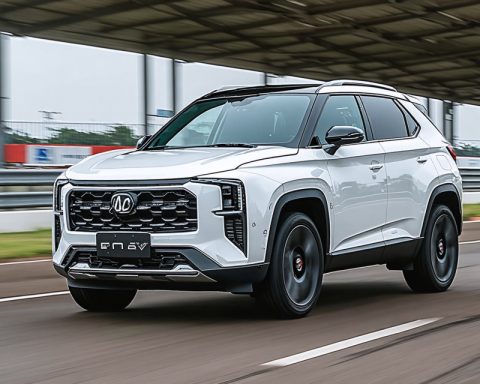- Autonomous vehicles are rapidly advancing, driven by innovations in artificial intelligence and sensor technology.
- Prominent manufacturers like Tesla and Waymo are pioneering self-driving technology, utilizing machine learning and extensive road testing.
- Self-driving cars promise numerous benefits, including reduced traffic congestion, fewer accidents, and decreased emissions.
- Autonomous vehicles offer increased mobility options for those unable to drive, such as the elderly and disabled.
- Achieving full autonomy requires building trust, ensuring safety, and securing regulatory approval.
- Challenges persist, including ethical decision-making and cybersecurity concerns.
- The development of autonomous vehicles will reshape the future of transportation, offering a safer and more efficient ecosystem.
Automotive technology is accelerating toward a future that once seemed like science fiction. Autonomous vehicles, once confined to the realm of imaginative storytelling, now promise to reshape how we navigate the world. With each passing year, advances in artificial intelligence and sensor technology bring the dream of self-driving cars ever closer to reality.
Picture this: A sleek car that electrifies the senses with its quiet hum and graceful, effortless glide through morning traffic. This is not a vision of a futuristic city but a scene unfolding in today’s urban landscapes. These autonomous vehicles, equipped with laser-sharp LIDAR and AI-driven decision-making, chart their routes with the precision of a seasoned navigator.
Manufacturers like Tesla, Waymo, and others are racing to perfect these marvels of engineering. Tesla’s autopilot system, for example, utilizes advanced machine learning algorithms to anticipate and respond to real-time road conditions. Meanwhile, Waymo has already clocked millions of miles on public roads, steadily ironing out the wrinkles of full autonomy.
Yet, the journey to a driverless future is not merely about technology—it’s about building trust. Autonomous vehicles must ensure safety, reliability, and efficacy against the unpredictable backdrop of human-driven environments. Experts note that achieving level 5 autonomy, where no human intervention is required, will hinge on rigorous testing and regulatory approval.
Intriguingly, the benefits of self-driving cars extend far beyond convenience. Imagine reclaiming time usually spent staring at endless traffic jams. Autonomous vehicles ponderous choreography could unclog roads, reduce accidents, and cut emissions by optimizing driving patterns. More importantly, these innovations promise to offer new mobility solutions to those unable to drive today, such as the elderly or disabled.
The road ahead is sure to include challenges. Ethical dilemmas, like decision-making in potential accident scenarios and cybersecurity threats, must be addressed. However, the potential reward—a safer, more efficient transportation ecosystem—compels continued exploration.
The autonomous vehicle is not just a car; it’s a catalyst for rethinking transportation. How we embrace and integrate this technology will define the coming era of mobility.
Unveiling the Future: How Autonomous Vehicles Will Redefine Transportation
Autonomous vehicles are no longer confined to the pages of science fiction; they are an unfolding reality with the potential to transform our daily lives and urban infrastructure. Let’s delve into some additional aspects of this burgeoning technology, offering insights into its capabilities, implications, and anticipated impacts.
How-To Steps & Life Hacks: Preparing for an Autonomous Future
1. Stay Informed: Follow reputed sources like Waymo and Tesla to keep up with the latest breakthroughs in autonomous vehicle technology.
2. Understanding Technology Basics: Familiarize yourself with key technologies such as LIDAR, radar, and machine learning algorithms, which are integral to the operation of self-driving cars.
3. Regulatory Updates: Keep track of policy changes and government regulations around autonomous vehicles to understand the legal landscape.
Real-World Use Cases
Autonomous vehicles are more than just a transportation innovation; they promise sweeping societal changes:
– Logistics and Delivery: Companies like Nuro are experimenting with driverless vehicles designed for delivering groceries and other goods.
– Accessibility Improvements: Autonomous vehicles are set to improve mobility for the elderly and disabled, providing a level of independence that current transportation options cannot.
Market Forecasts & Industry Trends
According to Allied Market Research, the global autonomous vehicle market is expected to reach $557 billion by 2026. Key trends include:
– Increased Partnerships: Collaborations among tech companies, automakers, and municipalities to accelerate the deployment of autonomous technologies.
– Shared Mobility Growth: The rise of shared autonomous vehicle fleets could reduce the need for personal car ownership, directly impacting urban planning and development.
Controversies & Limitations
While the promise of self-driving cars is tantalizing, they are not without controversy:
– Ethical Dilemmas: Decision-making algorithms must be programmed to handle scenarios with moral implications, such as accident avoidance strategies.
– Cybersecurity Risks: As autonomous vehicles become more connected, they are vulnerable to hacking and data breaches, raising concerns about user privacy and safety.
Insights & Predictions
Experts predict that by the late 2020s, autonomous vehicles could make up a significant portion of urban transportation networks. This transformation may result in:
– Decreased Traffic Congestion: Optimized routing and driving efficiency might lead to smoother traffic flow.
– Environmental Benefits: Coordinated driving patterns and electric drivetrains could significantly cut emissions.
Recommendations
1. Consumer Awareness: Education programs should focus on familiarizing the public with autonomous vehicle technology and its benefits.
2. Infrastructure Development: Governments should prioritize building smart city infrastructures that can support autonomous vehicles, ensuring seamless integration into current transportation networks.
3. Focus on Safety: Developers and manufacturers must prioritize robust testing processes to ensure safety and reliability in real-world scenarios.
Conclusion
Autonomous vehicles are poised to become an integral part of modern transportation. Embracing this technology requires overcoming significant challenges but promises an era marked by increased safety, efficiency, and accessibility. Equip yourself with knowledge and remain adaptable to take full advantage of the breakthroughs in this exciting field.






















